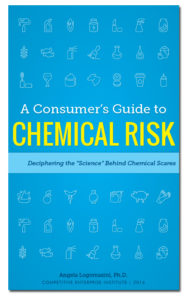Researchers measure the strength of associations by assessing the “relative risk” of a chemical. This involves comparing groups of individuals with high exposures to groups of individuals with low or no exposures. In the observational studies, if the group (or groups) with higher exposure to a chemical experiences more health ailments, researchers report an association between the chemical and the illnesses they discover. They then engage in calculations to express the strength of that association numerically as a risk ratio.
If the risk ratio is 1, then the study reports no difference between the groups. If the level is higher than 1, the research indicates a statistical association between health problems and the chemical exposure. When the number is less than 1, the research indicates an association between high chemical exposures and better health—what drug researchers seek when conducting drug trials. Steve Milloy explains it well in Junk Science Judo:
A relative risk of 1.0 means there is no difference in the rate of disease between two study populations. A relative risk of 2.0 means that the study population with the exposure of interest has double the rate of disease (100 percent more) than the non-exposed population. A relative risk of 3.0 means the rate is three times as high (200 percent more) … and so forth. (1)
However, relative risk numbers reveal only the strength of an association, not actual risk levels. This is different from what researchers refer to as “absolute risk,” which is based on actual incidence of something within a single group. For example, if one out of 1,000 Americans contracts a disease annually, the absolute risk for Americans would be 0.1 percent or expressed as a ratio of 0.01. If we compare risks associated with a smaller population with twice the level of illnesses than experienced in our sample of 1,000 Americans, we find a relative risk of two, which indicates 100 percent more illnesses in this second group than in the larger group. In this situation, the absolute risk of being in the smaller group increases to 0.2 percent or 0.02.
While a 100 percent increase in illnesses might sound like a large increase, studies finding a relative risk of 2 or even 3 are not particularly compelling and are considered weak associations. Mount Sinai School of Medicine epidemiologist Paolo Boffetta explains: “Although any measure of risk would follow a continuous distribution and there are no predefined values that separate ‘strong’ from ‘moderate’ or ‘weak’ associations, relative risks below 3 are considered moderate or weak.”(2)
It is true that when risks are high, relatively small increases may translate into a large number of people facing a higher risk. But what if the absolute risk of the first group is extremely low? Being two, three, four times or even 10 times more likely to suffer effects of a negligible risk may still mean that an individual’s absolute risk remains negligible.
Sarah Williams of the United Kingdom’s nonprofit cancer research institute, Cancer UK, notes:
Recently, the Guardian looked at a “70% increase” in cancer among women after the Fukushima Daiichi nuclear disaster. This was actually drawn from statistics showing an increase in absolute risk from 0.77 per cent to 1.29 per cent (this is indeed a 70 per cent increase). But, as reported by the Wall Street Journal … the absolute increase is ‘tiny’ – about 0.5 per cent.(3)
In Statistics Explained, Professor Steve McKillup of Central Queensland University uses the lottery as an example of how even seemingly big increases in relative risk (in this case chance of winning) do not dramatically change probability. If buying a lottery ticket gives you a one in 10 million chance of winning, you can increase your chances 10 times simply by purchasing 10 tickets. Yet the probability that you will win is still very low (one in 1 million).(4) Similarly, the risk of being killed by a lightning strike is very low at about 0.25 per 1 million people. For example, people in Kansas face a risk that is more than double, but that’s still only 0.57 percent per million.(5)
When it comes to studies attempting to link chemicals and health ailments, the absolute risks are largely theoretical and generally too low to measure. This is one reason not to panic when studies report an association showing that one group of individuals exposed to certain chemicals suffered two or three times more health problems than people in other groups.
After calculating the risk ratios, researchers then assess whether the finding is statistically significant.
Browse the terms on the sidebar of this webpage for more information and/or download a copy of A Consumer’s Guide to Chemical Risk: Deciphering the “Science” Behind Chemical Scares.
(1) Steven J. Milloy, Junk Science Judo: Self-Defense Against Health Scares & Scams (Washington, D.C.: Cato Institute, 2001), 102.
(2) Paolo Boffetta, “Causation in the Presence of Weak Associations,” Critical Reviews in Food Science and Nutrition 51, supp. 1 (December 4, 2010):13–16.
(3) Sarah Williams, “Absolute Versus Relative Risk – Making Sense of Media Stories,” Science Update Blog
(project of hosted by the nonprofit Cancer Research UK), March 15, 2013.
(4) Steve McKillup, Statistics Explained: An Introductory Guide for Life Scientists (New York: Cambridge University Press, 2012), p. 73.
(5) Mark Battersby, Is That a Fact? A Field Guide for Evaluating Statistical and Scientific Information (Ontario: Broadview Press, 2009), 203, 231.


